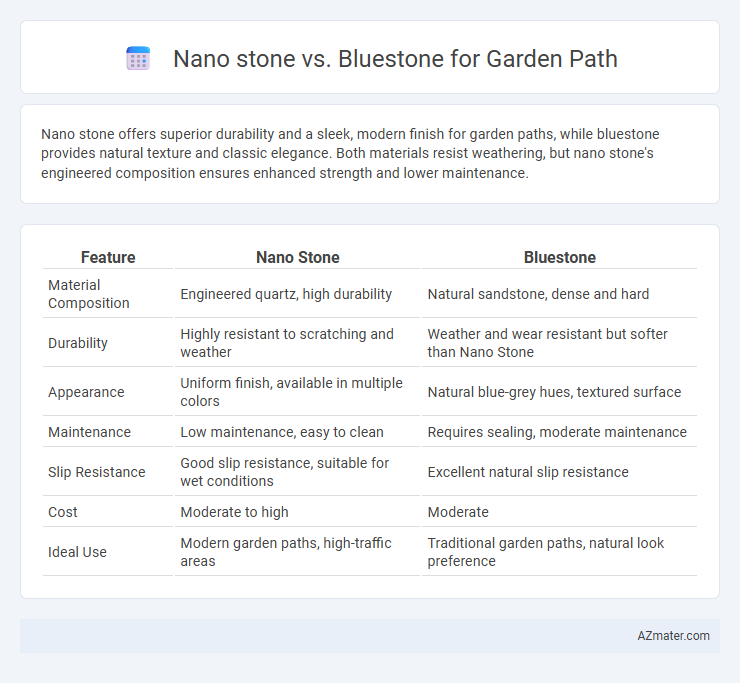Nano stone offers superior durability and a sleek, modern finish for garden paths, while bluestone provides natural texture and classic elegance. Both materials resist weathering, but nano stone's engineered composition ensures enhanced strength and lower maintenance.
Table of Comparison
| Feature | Nano Stone | Bluestone |
|---|---|---|
| Material Composition | Engineered quartz, high durability | Natural sandstone, dense and hard |
| Durability | Highly resistant to scratching and weather | Weather and wear resistant but softer than Nano Stone |
| Appearance | Uniform finish, available in multiple colors | Natural blue-grey hues, textured surface |
| Maintenance | Low maintenance, easy to clean | Requires sealing, moderate maintenance |
| Slip Resistance | Good slip resistance, suitable for wet conditions | Excellent natural slip resistance |
| Cost | Moderate to high | Moderate |
| Ideal Use | Modern garden paths, high-traffic areas | Traditional garden paths, natural look preference |
Introduction to Nano Stone and Bluestone
Nano stone is an innovative, engineered material known for its durability, non-porous surface, and low maintenance, making it ideal for modern garden paths. Bluestone, a natural sandstone, is prized for its rich blue-gray color, textured surface, and traditional aesthetic in landscaping projects. Both materials offer unique benefits, with nano stone providing enhanced resistance to weathering and bluestone offering timeless beauty and natural slip resistance.
Material Composition and Properties Comparison
Nano stone consists of engineered materials that combine natural stone aggregates with resin binders, resulting in a lightweight yet durable surface ideal for garden paths. Bluestone is a dense, natural sandstone known for its high compressive strength and slip-resistant texture, making it a resilient option for outdoor walkways. Comparing these materials, nano stone offers greater flexibility and uniformity in color and texture, while bluestone provides authentic natural aesthetics and superior weather resistance.
Aesthetic Appeal: Texture and Color Variations
Nano stone offers a refined, smooth texture with subtle color variations that create a sleek and modern aesthetic for garden paths. Bluestone features a natural, rugged texture with rich blue-gray hues and organic color shifts, enhancing a classic, rustic charm. The choice between Nano stone's consistent finish and Bluestone's dynamic palette directly impacts the visual appeal and style cohesion of outdoor landscaping.
Durability and Weather Resistance
Nano stone offers superior durability with high resistance to cracking and chipping, making it ideal for garden paths exposed to heavy foot traffic. Bluestone demonstrates excellent weather resistance, particularly in harsh climates, due to its dense composition and natural ability to withstand freeze-thaw cycles. When choosing between the two, nano stone's engineered strength provides long-lasting performance, while bluestone's natural resilience ensures sustained aesthetic appeal and structural integrity in various weather conditions.
Installation Process and Ease
Nano stone offers a lightweight and uniform size advantage, making the installation process quicker and less labor-intensive compared to traditional bluestone. Bluestone requires careful leveling and placement due to its heavier, irregular slabs, demanding more time and physical effort during installation. Homeowners often find nano stone easier to handle and adjust, resulting in smoother project completion and fewer complications.
Maintenance Requirements and Longevity
Nano stone offers low maintenance requirements due to its dense structure that resists staining and weathering, making it ideal for busy garden paths. Bluestone, while durable and attractive, demands more upkeep like regular sealing to prevent moisture damage and surface wear over time. Nano stone typically boasts a longer lifespan in outdoor settings because of its enhanced durability against environmental factors compared to bluestone.
Environmental Impact and Sustainability
Nano stone offers a lower environmental impact than bluestone due to its manufacturing process, which typically uses recycled materials and less energy-intensive production techniques. Bluestone, though natural and durable, involves quarrying that can disrupt ecosystems and increase carbon emissions through transportation. Choosing nano stone for garden paths often supports sustainable landscaping by reducing resource depletion and promoting eco-friendly material reuse.
Cost Analysis and Value for Money
Nano stone offers a premium option for garden paths with its advanced durability and sleek appearance, typically costing 20-30% more than bluestone. Bluestone remains a cost-effective choice, known for its natural texture and resilience, priced lower yet providing strong value for budget-conscious landscaping. When evaluating cost analysis, nano stone's longevity and minimal maintenance can justify the higher upfront expense, delivering better long-term value for money compared to bluestone.
Safety Considerations: Slip Resistance and Edges
Nano stone offers superior slip resistance due to its finely textured surface, reducing the risk of slips on wet garden paths. Bluestone, while durable, can become slippery when polished or wet and may require additional treatment to enhance traction. The edges of nano stone are often smoother and more uniform, minimizing tripping hazards compared to the sometimes rough or uneven edges of bluestone slabs.
Choosing the Right Stone for Your Garden Path
Nano stone offers a sleek, modern appearance with enhanced durability and low maintenance, making it ideal for minimalist garden paths that require resilience against weather and foot traffic. Bluestone, known for its natural texture and rich color variations, provides a classic, rustic charm perfect for gardens emphasizing organic aesthetics and traditional landscaping. Selecting the right stone depends on your garden's style, desired durability, and maintenance preferences, ensuring the path complements both functionality and visual appeal.

Infographic: Nano stone vs Bluestone for Garden Path
 azmater.com
azmater.com